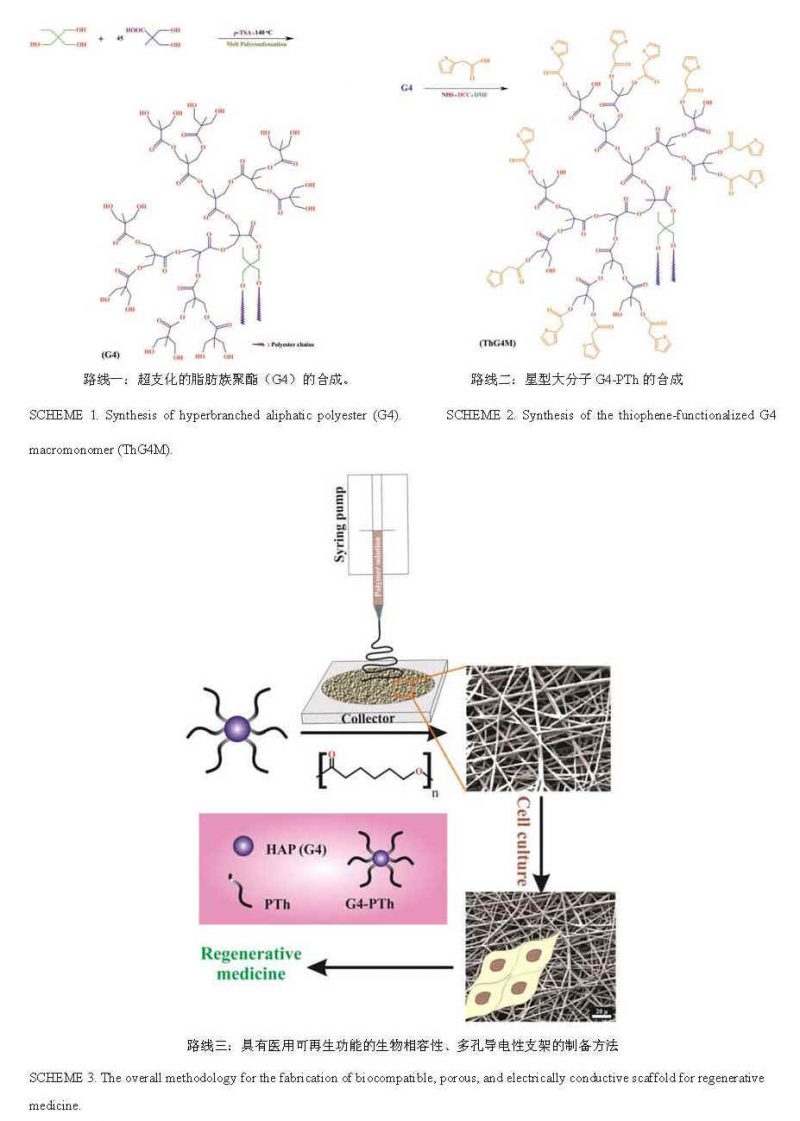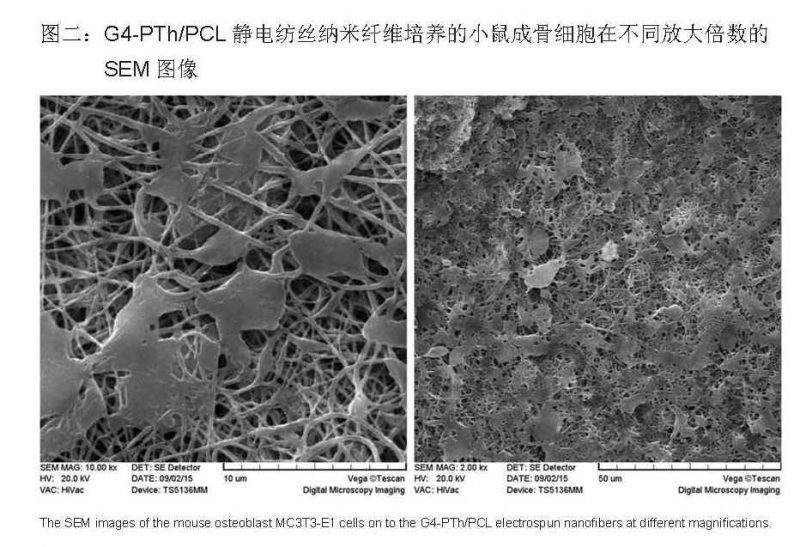|
基于超支化的聚噻吩-聚酯导电智能材料 在过去的十年里,通过传递人细胞外基质(ECM)应用于病变或受损组织再生的新型多功能材料支架得到了很大的发展。再生医学支架必须具备以下的性能:(1)具有良好的生物相容性和生物降解性;(2)合适的微观结构、力学特性;(3)良好的表面形貌和化学成分。(4)制造工艺简单,成本低。 众多材料中,聚噻吩(PTH)及其衍生物(例如聚(3,4-二氧乙撑噻吩))由于具有独特的物理化学性质(优异的环境热稳定性,电导率、机械强度、光磁性能优异,合成过程简单,合成成本低)广泛应用于导电性支架。 除此之外,脂肪族聚酯具有良好的生物相容性、生物降解性以及低成本的优点,使其成为合成理想型支架的原料。其中,基于2 -二(羟甲基)丙酸的超支化聚酯由于其高度支化的结构和大量的官能团数,独特的物理化学性质,在工业和医学领域具有显著的优势,引起了许多科研工作者的关注。 静电纺丝技术能制备出具有生物相容性的能模仿出ECM结构及生物功能的导电纳米纤维。在过去的十年里,这项技术在制备导电性支架方面引起了人们的广泛关注。另外,制备出的支架具有孔隙度高、比表面积大,长纤维超薄、孔径分布可调、过程简单和成本较低的优点。 最近,伊朗大不里士医科大学的Mehdi Jaymand和Morteza Eskandani通过静电纺丝的方法成功的制备了一种新型的含有超支化的脂肪族聚酯(HAP)、聚噻吩(PTh)和聚己内酯(PCL)的导电性支架。其具体的合成过程如下,首先,三(羟甲基)丙烷、2,2-双(羟甲基)丙酸(二-MAP)通过熔融缩聚反应合成HAP (G4;第四代)。接着,以DCC、NHS为催化剂,用2-噻吩乙酸修饰HAP,合成出噻吩功能化的G4大分子单体。然后,通过化学氧化共聚合的方法将噻吩单体和G4大分子单体聚合,合成出PTh包裹G4核的星型大分子(G4-PTh)。最后,通过静电纺丝的方法,将G4- PTh和PCL的溶液制备出导电性、生物相容性的纳米纤维。静电纺丝的纳米纤维通过粘附实验、小鼠成骨细胞(MC3T3-E1)的增殖实验、体外降解实验进行评估,进而说明这种材料在组织工程支架方面有一定的应用前景。 J Biomed Mater Res Part A 2016:104A:2673–2684. Introduction The last decade has witnessed the design and development of novel multifunctional materials for application in regeneration replacement of damaged or diseased tissues by delivering human extracellular matrix (ECM) components. The scaffolds for regenerative medicine must possess some properties as follows: (1) biocompatibility and biodegradability, (2) suitable microstructures, and mechanical characteristics, (3) proper surface topography and chemical composition, (4) simple and cost-effective fabrication technology. In many polymer materials,because of their unique physicochemical properties including excellent environmental-thermal stabilities,high electrical conductivities、mechanical strengths、magnetic、optical properties,ease synthesis and low costs, polythiophene (PTh), and its derivatives (especially poly(3,4-ethylenedioxythiophene)) have been witnessed an immense interest for the fabrication of conductive scaffolds.Furthermore, aliphatic polyesters may be an appropriate candidate for the synthetic desired scaffolds, because of their biocompatibility, biodegradability, and low costs. Among the aliphatic polyesters, the hyperbranched polyesters based on 2, 2- bis (methylol) propionic acid have stimulated great interest, mainly due to their highly branched structure and the large number of functional groups, unique physicochemical properties, and significant advantage for industrial and biomedical applications.The electrospinning is suggested as an efficient approach to prepare biocompatible conductive nanofibers to mimic the architecture and biological functions of the ECM. This technique has attracted a great deal of attention in the past decade for fabrication of conductive scaffolds, mainly due to high porosity, high surface-to-volume ratio, ultrathin continuous fibers, adjustable pore size distribution as well as its simplicity and more cost-effectivity. The achievement in scientific research Recently,Mehdi Jaymand and Morteza Eskandani who working in theTabriz University of Medical Sciences made the following outcome. A novel electrically conductive scaffold containing hyperbranched aliphatic polyester (HAP), polythiophene (PTh), and poly(e-caprolactone) (PCL) for regenerative medicine application was succesfully fabricated via electrospinning technique. For this purpose, the HAP (G4; fourth generation) was synthesized via melt polycondensation reaction from tris (methylol) propane and 2,2-bis(methylol)propionic acid (bis-MPA).Afterward, the synthesized HAP was functionalized with 2-thiopheneacetic acid in the presence of N,N-dicyclohexyl carbodiimide, and N-hydroxysuccinimide as coupling agent and catalyst, respectively, to afford a thiophene-functionalized G4 macromonomer .This macromonomer was subsequently used in chemical oxidation copolymerization with thiophene monomer to produce a starshaped PTh with G4 core (G4-PTh). The solution of the G4- PTh, and PCL was electrospun to produce uniform, conductive, and biocompatible nanofibers. The conductivity, hydrophilicity, and mechanical properties of these nanofibers were investigated. The biocompatibility of the electrospun nanofibers were evaluated by assessing the adhesion and proliferation of mouse osteoblast MC3T3-E1 cell line and in vitro degradability to demonstrate their potential uses as a tissue engineering scaffold. Conclusion A novel three-dimensional, conducting, biocompatible, and porous scaffold composed of hyperbranched aliphatic polyester, polythiophene, and poly(e-caprolactone) for application in regenerative medicine would be potentially used for tissue engineering. (闫欢欢) |

